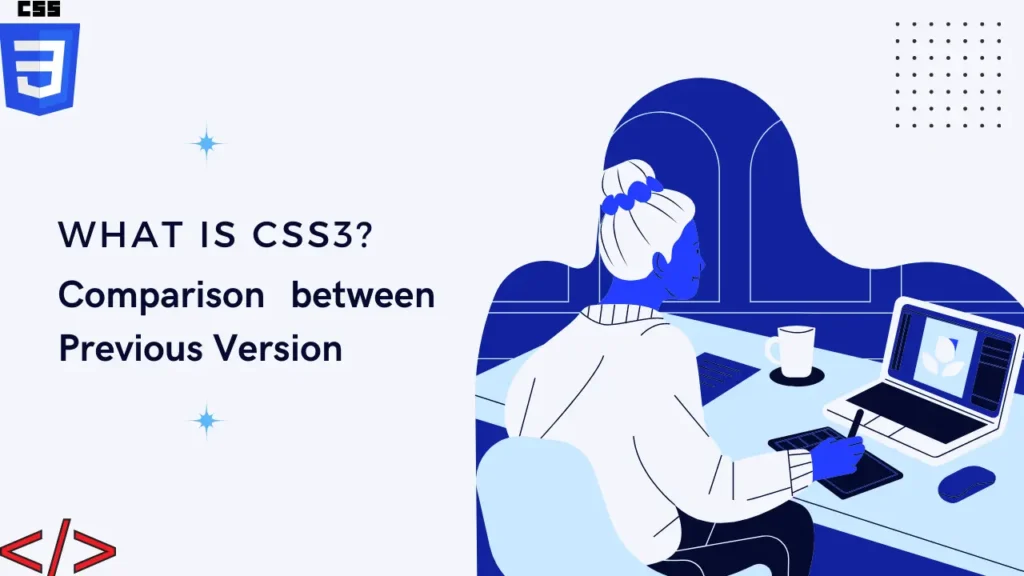What is CSS3
Cascading Style Sheets level 3, or CSS3, is the modern web page style standard. It is a powerful language that allows web developers to control HTML document layout, design, and presentation. With CSS3, developers can create visually appealing and interactive websites, enhance user experience, and make web pages responsive across different devices.
Introduction
CSS3 is crucial in transforming plain HTML documents into visually captivating and engaging websites in web development. By applying CSS3 styles to HTML elements, developers can control the colours, fonts, layouts, animations, and other web page aspects. CSS3 has revolutionized how web pages are designed and presented, offering many features and capabilities.
Evolution of CSS
CSS3 is the latest iteration of the CSS specification. To understand its significance, it is essential to trace the evolution of CSS from its earlier versions.
CSS1
CSS1 was introduced in 1996 and provided the foundation for separating the presentation layer from the structure of web documents. It taught basic styling features like font styles, colours, and margins.
CSS2
CSS2, released in 1998, expanded the capabilities of CSS1 by introducing advanced selectors, positioning options, and the concept of media types. It provided more control over the layout and presentation of web pages.
CSS3
CSS3, which started to gain widespread adoption in the early 2010s, brought many new features and improvements to CSS. It introduced exciting possibilities for web designers and developers, enabling them to create sophisticated and interactive websites.
Key Features of CSS3
CSS3 incorporates numerous powerful features that enhance the styling capabilities of web developers. Some of the key features include:
Selectors
CSS3 introduced new selectors that enable developers to target specific elements more precisely. Selectors like attribute selectors, pseudo-classes, and pseudo-elements offer more control over element selection and styling.
Box Model
The box model in CSS3 allows developers to define the dimensions and spacing of elements on a web page. It includes properties such as margin, padding, border, and content width, enabling precise control over the layout.
Text Effects
CSS3 provides various text effects, such as shadows, gradients, transformations, and animations. These effects allow designers to create visually appealing typography and enhance the user experience.
Transitions and Animations
With CSS3, developers can create smooth transitions and animations between different states of an element. This feature adds interactivity and dynamism to web pages, making them more engaging for users.
Flexbox and Grid Layout
CSS3 introduced flexible box layout (Flexbox) and grid layout, simplifying the creation of responsive designs. These layout models provide powerful tools for building flexible and adaptive web page layouts.
Media Queries
Media queries in CSS3 enable developers to apply different styles based on the characteristics of the user’s device, such as screen size, resolution, or orientation. This feature is crucial for creating responsive designs that adapt to various devices.
Custom Fonts
CSS3 allows custom fonts, providing designers with many typography options. By leveraging web fonts, developers can ensure consistent and visually appealing typography across different platforms.
Responsive Design
CSS3 greatly facilitates the creation of responsive designs, which adapt seamlessly to different screen sizes and devices. This capability is vital in today’s mobile-first world, where users access websites on various devices.
Advantages of CSS3:
- Enhanced Design Capabilities: CSS3 offers various design options, allowing developers to create visually stunning websites with advanced styling and effects.
- Improved User Experience: With CSS3 animations, transitions, and interactive elements, developers can create engaging and intuitive user experiences, enhancing user satisfaction and retention.
- Efficient Development: CSS3 simplifies building responsive and adaptive designs, saving developers time and effort. It creates consistent styles across multiple pages or websites through reusable style sheets.
- Cross-Browser Compatibility: CSS3 is supported by modern web browsers, ensuring consistent rendering of styles across different platforms and reducing the need for browser-specific code.
- Performance Optimization: CSS3 allows for optimized web page performance by reducing the need for additional images, minimizing file sizes, and utilizing hardware-accelerated animations.
- Flexibility and Modularity: CSS3 enables developers to separate the structure and presentation of web pages, making it easier to maintain and update styles across the entire site. It also promotes code reusability and modularity, improving development efficiency.
Disadvantages of CSS3:
- Limited Browser Support for Older Versions: While modern browsers support CSS3, older versions may have limited support or lack support for certain CSS3 features. This requires developers to provide fallback options or alternative styling approaches for older browsers.
- Learning Curve: CSS3 introduces new concepts and features that may require additional learning for developers accustomed to earlier CSS versions. Keeping up with new updates and best practices in CSS3 can be time-consuming.
- Complexity for Advanced Effects: While CSS3 offers powerful styling capabilities, achieving complex effects may require extensive knowledge and understanding of CSS3 properties, selectors, and animations. Developing intricate designs can be challenging and time-consuming.
- Performance Considerations: Using excessive CSS3 animations and effects can negatively impact website performance, particularly on older devices or slower internet connections. It is essential to optimize CSS code and consider performance implications when using resource-intensive features.
- Browser Compatibility Issues: Despite the widespread adoption of CSS3, there may still be inconsistencies in how different browsers interpret and render certain CSS3 features. Testing and ensuring cross-browser compatibility is crucial to maintaining consistent designs.
- Accessibility Challenges: Implementing CSS3 features without proper consideration for accessibility can lead to usability issues for users with disabilities. Developers must ensure that CSS3 styles do not hinder accessibility features, such as screen readers or keyboard navigation.
Comparison between previous versions of CSS
Advantages of CSS3 compared to previous versions of CSS:
- Expanded Styling Capabilities: CSS3 introduces a wide range of new styling features and properties that were not available in previous versions. This includes advanced selectors, gradients, shadows, transformations, animations, and more. These additions give web developers greater flexibility and creativity in designing visually appealing websites.
- Enhanced Layout Control: CSS3 introduces new layout modules like Flexbox and Grid Layout, which offer powerful tools for creating responsive and dynamic page layouts. These layout systems simplify the process of building complex, multi-column, and responsive designs, reducing the need for workarounds and hacks used in older versions of CSS.
- Improved Browser Support: CSS3 enjoys better support across modern web browsers than in previous versions. Most major browsers have implemented CSS3 features, reducing the need for browser-specific CSS hacks or conditional stylesheets. This results in more consistent rendering of styles across different browsers and improved cross-browser compatibility.
- Responsive Design Made Easier: CSS3 includes media queries, which allow developers to apply different styles based on the characteristics of the user’s device, such as screen size, resolution, or orientation. This makes creating responsive designs that adapt seamlessly to various devices easier, improving the user experience.
- Simplified Animation and Transitions: CSS3 introduces native support for animations and transitions, eliminating the need for JavaScript or Flash-based solutions. Developers can easily create smooth animations, transitions, and interactive effects using CSS3, resulting in more engaging and visually appealing websites.
- Modularity and Reusability: CSS3 promotes modular and reusable code through selectors, inheritance, and cascading features. Developers can define styles once and apply them to multiple elements throughout the website, reducing redundancy and making styles easier to maintain and update.
- Improved Performance Optimization: CSS3 offers performance benefits through hardware-accelerated animations, optimized rendering, and reduced image reliance. This leads to faster loading times, improved site performance, and a better user experience.
Browser Support for CSS3
Modern web browsers, like Google Chrome, Mozilla Firefox, Safari, and Microsoft Edge, widely support CSS3. However, some older versions of Internet Explorer may have limited support for certain CSS3 features. Developers must consider browser compatibility and provide fallback options when using CSS3 features that may not be supported in all browsers.
Common CSS3 Mistakes to Avoid
While CSS3 offers powerful features, it’s essential to use them judiciously and avoid common pitfalls. The following are common mistakes that should be avoided while working with CSS3:
- Overusing Animations: Excessive use of animations can negatively impact a website’s performance and user experience. It is important to use animations sparingly and ensure they enhance the overall design rather than overshadow it.
- Ignoring Browser Compatibility: Although CSS3 is widely supported, testing and ensuring that styles render correctly across different browsers and versions is essential. Providing fallback options for older browsers can help maintain a consistent user experience.
- Not Optimizing for Performance: Large and unoptimized CSS files can slow down a website’s loading time. It is essential to optimize CSS code, remove unused styles, and minimize file sizes to improve performance.
Best Practices for Using CSS3
To make the most of CSS3, consider the following best practices:
- Use Proper Vendor Prefixes: Some CSS3 features may require vendor prefixes to ensure compatibility with different browsers. Include appropriate prefixes for specific CSS properties to ensure consistent rendering.
- Organize CSS Code: Maintain a well-structured and organized CSS codebase by using meaningful class names, commenting, and grouping related styles together. Including this improves the code’s readability, maintainability, and scalability.
- Minify and Concatenate CSS Files: Reduce the file size and improve website loading speed by minifying and concatenating CSS files. This process removes unnecessary characters and combines multiple CSS files into a single file.
Future of CSS3
CSS3 continues to evolve, with ongoing updates and new features being proposed and implemented. The future of CSS3 looks promising, with advancements in layout systems, typography, and responsive design. As web technologies and user expectations evolve, CSS3 will play a crucial role in shaping the visual experience of the web.
Conclusion
CSS3 is a powerful tool that empowers web developers and designers to create visually appealing and interactive websites. Its extensive range of features and capabilities enables the creation of modern, responsive, and engaging web experiences. By understanding and leveraging the potential of CSS3, developers can elevate their web projects’ design and user experience.
FAQs
Q: Can CSS3 be used with older versions of HTML?
Ans: Yes, CSS3 can be used with older versions of HTML. CSS is designed to be backward compatible, meaning that newer CSS features can be applied to older HTML documents. However, certain CSS3 features may need to be revised in older browsers.
Q: Is CSS3 a programming language?
Ans: No, CSS3 is not a programming language. It is a style sheet language used to describe the visual presentation of a document written in HTML or XML. While CSS3 introduces some dynamic and interactive features, it is primarily focused on styling and layout.
Q: Are there any disadvantages to using CSS3?
Ans: While CSS3 offers numerous benefits, it is important to consider specific considerations. Some older browsers may have limited support for CSS3 features, which may require fallback options or alternative approaches. Additionally, using complex CSS3 animations and effects excessively can impact performance.
Q: How can I check if my browser supports CSS3?
Ans: Various online resources and compatibility tables provide information on CSS3 features and their browser support. Additionally, you can test CSS3 features directly in different browsers or use feature detection libraries like Modernizr to check for specific capabilities.
Q: Can CSS3 animations be used on mobile devices?
Ans: Yes, CSS3 animations can be used on mobile devices. Modern mobile browsers support CSS3 features, including animations. However, optimizing animations for performance and considering the limited resources of mobile devices to ensure a smooth user experience is essential.



